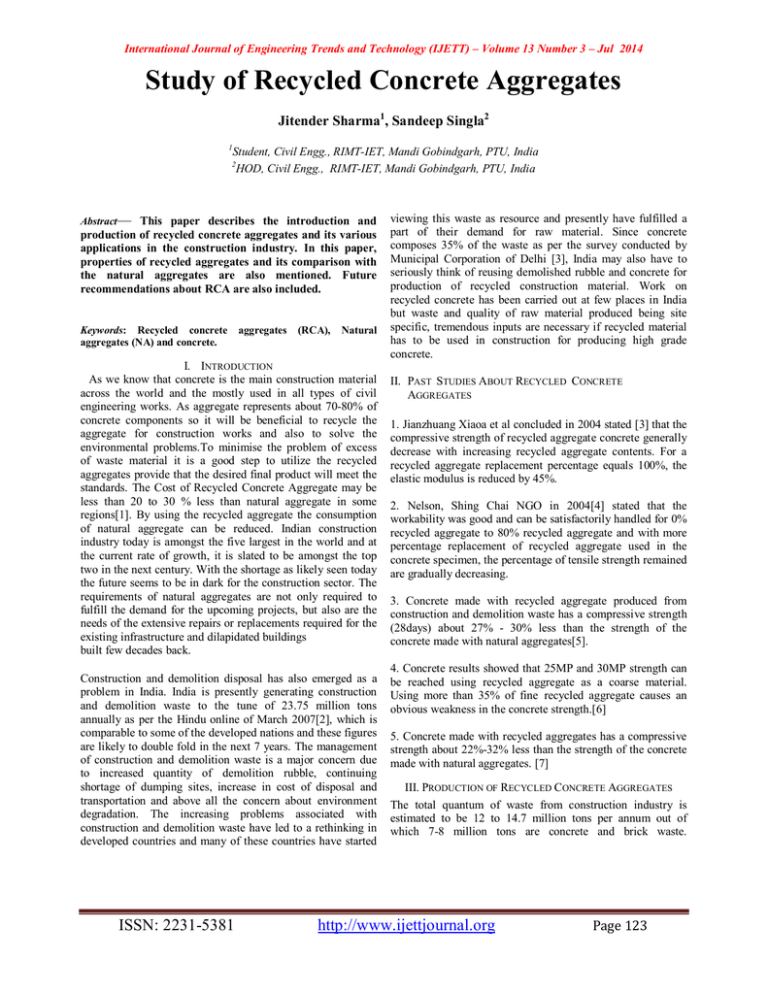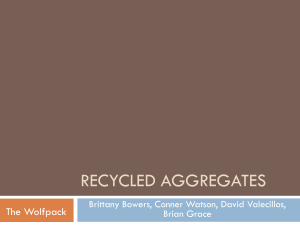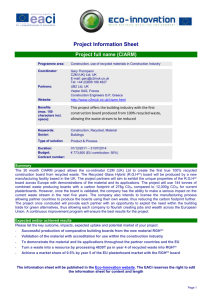Study of Recycled Concrete Aggregates Jitender Sharma , Sandeep Singla
advertisement

International Journal of Engineering Trends and Technology (IJETT) – Volume 13 Number 3 – Jul 2014 Study of Recycled Concrete Aggregates Jitender Sharma1, Sandeep Singla2 1 Student, Civil Engg., RIMT-IET, Mandi Gobindgarh, PTU, India HOD, Civil Engg., RIMT-IET, Mandi Gobindgarh, PTU, India 2 Abstract— This paper describes the introduction and production of recycled concrete aggregates and its various applications in the construction industry. In this paper, properties of recycled aggregates and its comparison with the natural aggregates are also mentioned. Future recommendations about RCA are also included. Keywords: Recycled concrete aggregates (NA) and concrete. aggregates (RCA), Natural I. INTRODUCTION As we know that concrete is the main construction material across the world and the mostly used in all types of civil engineering works. As aggregate represents about 70-80% of concrete components so it will be beneficial to recycle the aggregate for construction works and also to solve the environmental problems.To minimise the problem of excess of waste material it is a good step to utilize the recycled aggregates provide that the desired final product will meet the standards. The Cost of Recycled Concrete Aggregate may be less than 20 to 30 % less than natural aggregate in some regions[1]. By using the recycled aggregate the consumption of natural aggregate can be reduced. Indian construction industry today is amongst the five largest in the world and at the current rate of growth, it is slated to be amongst the top two in the next century. With the shortage as likely seen today the future seems to be in dark for the construction sector. The requirements of natural aggregates are not only required to fulfill the demand for the upcoming projects, but also are the needs of the extensive repairs or replacements required for the existing infrastructure and dilapidated buildings built few decades back. Construction and demolition disposal has also emerged as a problem in India. India is presently generating construction and demolition waste to the tune of 23.75 million tons annually as per the Hindu online of March 2007[2], which is comparable to some of the developed nations and these figures are likely to double fold in the next 7 years. The management of construction and demolition waste is a major concern due to increased quantity of demolition rubble, continuing shortage of dumping sites, increase in cost of disposal and transportation and above all the concern about environment degradation. The increasing problems associated with construction and demolition waste have led to a rethinking in developed countries and many of these countries have started ISSN: 2231-5381 viewing this waste as resource and presently have fulfilled a part of their demand for raw material. Since concrete composes 35% of the waste as per the survey conducted by Municipal Corporation of Delhi [3], India may also have to seriously think of reusing demolished rubble and concrete for production of recycled construction material. Work on recycled concrete has been carried out at few places in India but waste and quality of raw material produced being site specific, tremendous inputs are necessary if recycled material has to be used in construction for producing high grade concrete. II. PAST STUDIES ABOUT RECYCLED CONCRETE AGGREGATES 1. Jianzhuang Xiaoa et al concluded in 2004 stated [3] that the compressive strength of recycled aggregate concrete generally decrease with increasing recycled aggregate contents. For a recycled aggregate replacement percentage equals 100%, the elastic modulus is reduced by 45%. 2. Nelson, Shing Chai NGO in 2004[4] stated that the workability was good and can be satisfactorily handled for 0% recycled aggregate to 80% recycled aggregate and with more percentage replacement of recycled aggregate used in the concrete specimen, the percentage of tensile strength remained are gradually decreasing. 3. Concrete made with recycled aggregate produced from construction and demolition waste has a compressive strength (28days) about 27% - 30% less than the strength of the concrete made with natural aggregates[5]. 4. Concrete results showed that 25MP and 30MP strength can be reached using recycled aggregate as a coarse material. Using more than 35% of fine recycled aggregate causes an obvious weakness in the concrete strength.[6] 5. Concrete made with recycled aggregates has a compressive strength about 22%-32% less than the strength of the concrete made with natural aggregates. [7] III. PRODUCTION OF RECYCLED CONCRETE AGGREGATES The total quantum of waste from construction industry is estimated to be 12 to 14.7 million tons per annum out of which 7-8 million tons are concrete and brick waste. http://www.ijettjournal.org Page 123 International Journal of Engineering Trends and Technology (IJETT) – Volume 13 Number 3 – Jul 2014 According to findings of survey, 70% of the respondent have given the reason for not adopting recycling of waste from Construction. Recycled aggregate is produced as a result of crushing, graded inorganic particles processed from the materials that have been used in the constructions. These materials resulted from destruction of buildings, roads, bridges, and sometimes even from catastrophes, such as wars and earthquakes. The raw materials used in the production of recycled aggregates come from demolition of pavements and buildings. This material is broken into large pieces and transported to the processing plant. It must be clean, free of contaminants like steel reinforcing bars, wood and soil. Then it passes through three main phases crushing, sizing and blending. The processes of recycling of construction and demolition wastes are similar to those producing natural aggregate both have the same equipments, crushers, screens, removal impurities and transportation facilities. FIGURE (1): E LECTROMAGNETIC SEPARATION PROCESS FIGURE (2): SCREENING PLANT IV. APPLICATIONS OF RCA Nowadays, the applications of recycled aggregate in construction areas are wide. The applications are different from country to country 1) Aggregate Base Course, or the untreated aggregates used as foundation for roadway pavement, is the underlying layer which forms a structural foundation for paving. 2) Ready Mix Concrete -It is used for residential slab and foundation; walk and curb residential street; commercial slab and foundation and concrete paving per aggregate approval. 3) Pipe Bedding: Recycled concrete can serve as a stable bed or firm foundation in which to lay underground utilities. 4) Paving Blocks: Recycled aggregate have been used as paving blocks in some countries. 5) Building Blocks: Recycled aggregate has been used as building blocks. 6) Value engineering benefits: Produce specification sized recycled aggregates at own location. Avoid haul-off costs and landfill disposal fees. Eliminate the expense of aggregate material imports and exports. Increase project efficiency and improve job cost - recycled concrete aggregates yield more volume by weight (up to 15%).. 7) Landscape Materials: Recycled concrete can be used in various landscape settings. Sized concrete rubble can serve as landscape feature. To date, recycled concrete aggregate has been used as boulder/stacked rock walls, underpass abutment structures, erosion structures, water features, retaining walls. V. PROPERTIES OF RCA 1. Shape and Texture- RCA aggregates, both coarse and fine, tend to be very angular and rough due to the crushing of the virgin aggregate particles and the presence of cement paste that continues to cling to the surfaces of the aggregate. 2. Absorption Capacity- The amount of water that an aggregate can absorb is called absorption capacity. The porous nature of the cement paste portion of the recycled aggregates increases its absorption capacity. Limiting the use of recycled fine aggregate will also reduce the absorption capacity of the aggregate. 3. Specific Gravity-It is a measure of the density of an aggregate. The lower specific gravity of RCA is due to the crushed mortar present in and on the aggregate particles which makes it less dense than NA because of its porosity and entrained air structure. 4. L.A. Abrasion Mass Loss- The loss for RCA is usually higher than NA. In general, the greater the loss the softer the aggregate and the less suitable it is for concrete. FIGURE (3): R ECYCLED AGGREGATE ISSN: 2231-5381 5. Chloride Content- There is concern that RCA with high chloride contents may affect the durability of the new concrete and the corrosion of steel in new concrete. http://www.ijettjournal.org Page 124 International Journal of Engineering Trends and Technology (IJETT) – Volume 13 Number 3 – Jul 2014 VI. COMPARISON BETWEEN RCA & NA From past studies it is found that:1. Recycled aggregate has rough – textured, angular and elongated particles where natural aggregate is smooth and rounded compact aggregate. 2. Recycled aggregate is well graded as natural aggregate. 3. The water absorption capacity of coarse recycled aggregate is about two times or more than natural coarse aggregates. 4. The dry density of coarse recycled aggregate is lower than dry density of natural aggregate. abrasion clearly indicate that RCAs are of lower quality than NCAs as they contain mortar. 4. From past studies it is cleared that 10% extra water and 5% extra cement should be preferred to produce a rich mix by using RCAs. 5. Recycled aggregate materials produce harsh mixes with lower workability than NAs. 6. New standards should be introduced for recycled aggregates so that these materials can be used successfully in future. 7. The 100% replacement of NA by RCA in concrete mixture may effect on chloride ions resistance, if proper design is not adopted. VIII. FUTURE RECOMMENDATIONS 1. From past studies and results it is recommended that proper design mixes with different percentage of recycled concrete aggregates with natural aggregates should be prepared to achieve the adequate strength of the concrete and to reduce the consumption of NA. 2. By using RCA the burden of construction wastes can be reduced to a suitable extent. 3. A suitable code of practice for recycled concrete aggregates should be prepared in which strength parameters about RCA are described. NA RCA IX. REFERENCES FIGURE (4): COMPARISON BETWEEN NA & RCA [1] Major Rakshvir, Sudhirkumar V. Barai- Studies on recycled aggregates-based concrete-Waste Management & Research, Vol. 24, No. 3, 225-233,2006. TABLE 1 Comparison Between NA & RCA Properties Property Shape Texture and Absorption Capacity Specific Gravity L. A. Abrasion Test Mass Loss Chloride Content NA Well rounded ,smooth to angular and rough 0.8-3.7 % RCA Angular with rough surface 3.7-8.7 % 2.4-2.9 2.1-2.4 15-30 % 20-45 % 0-1.2 kg/m3 0.6-7.1 kg/m3 VII .CONCLUSION 1. When the water cement ratio used in recycled aggregate mix is reduced, tensile strength and modulus of elasticity are improved. 2. The RCA replaced mixes have greater water absorption and porosity than normal mix but within the permissible limits. These properties can be modified by reducing the w/c ratio. 3. The specific gravity, water absorption and Los Angeles ISSN: 2231-5381 [2] The HINDU, Online edition of India’s National Newspaper, Wed Mar’07. [3] Jianzhuang Xiaoa,*, Jiabin Lia, Ch. Zhangb Mechanical properties of recycled aggregate concrete underuniaxial loading aDepartment of Building Engineering, Tongji University, Shanghai 200092, China, bDepartment of Civil Engineering, University of Applied Sciences Zittau/Go¨ rlitz, D-02763 Zittau, Germany Received 17 June 2004; accepted 23 September 2004. [4] Nelson and Shing Chai NGO Research Project "High-Strength Structural Concrete with Recycled Aggregates", submitted November 2004, University of Southern Queensland Faculty of Engineering Surveying http://eprints.usq.edu.au/21. [5] Rifat Rustom, Salah Taha, Ali Badarnah and Hani Barahma, PROPERTIES OF RECYCLED AGGREGATE IN CONCRETE AND ROAD PAVEMENT APPLICATIONS, The Islamic University Journal (Series of Natural Studies and Engineering) Vol.15, No. 2, pp 247-264, 2007, ISSN 1726-6807, http://www.iugaza.edu.ps/ara/research. [6] Ahmad S Subaih, Ahmad I El-Mankoush, Ali H el-Salmy and Amer h Wadi, Recycling of construction & demolition debris as an aggregate for base,sub-base in roads and as well as in concrete, Graduation project 2005. [7] Ramadan y.al Khatib,ahmad A. Khattab and salah a. Taha,Recycling "Construction and Demolition Wastes", Graduation project 1999 . http://www.ijettjournal.org Page 125





